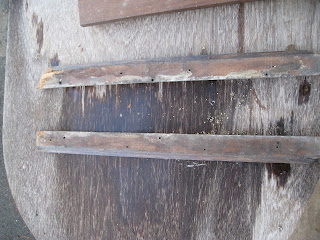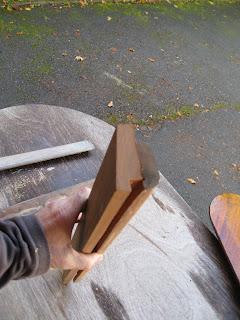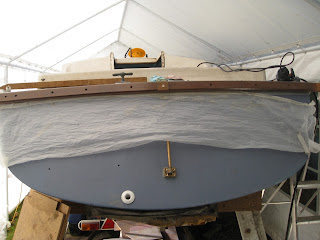When I got my boat and had a good look at the various bits that came with it I never once thought about the gooseneck fitting on the mast. I was cleaning the mast the other day and thought now how on earth will the boom fit on the mast.
 The boom has a fitting that would seem to go onto a 1" T track. On the mast there is a section 15" long where a track should have been fitted but no track. I have scoured the internet and found lots of places that sell track but I did not want a metre of it and it is quite expensive so I set about making my own.
The boom has a fitting that would seem to go onto a 1" T track. On the mast there is a section 15" long where a track should have been fitted but no track. I have scoured the internet and found lots of places that sell track but I did not want a metre of it and it is quite expensive so I set about making my own. This is the back of the mast where the track should have been. The three holes in the middle are larger than the top and bottom ones and there did not appear to be any thread on them. The top and bottom holes looked as though self tapping screws had been used.
I have a piece of aluminium the right thickness and cut a piece 1" wide by 15" long. I filed the edges and finished them on my belt sander making sure the track fitted nicely through the boom fitting. I then made a template of the holes on the mast so I could locate them when I drilled through the track.
Now I was going to cut a similar piece of aluminium about 1/2" wide to go under the forst piece making my T section but then hit on the idea of using some thick aluminium tubing as a spacer where each bolt went through to bolt the track to the mast. I think this will work quite well but time will tell. If there is too much pressure on the track then it may bend as it does not have the rigidity of proper T track.
I have drilled the track and tapped the holes in the mast as seen above, to take 5mm countersunk bolts and I will put a stopper at the bottom to stop the gooseneck slider coming off the track. I may want to pull the boom off the top of the track so I will leave that.
I will amend this posting once I have fitted on the mast. Another possible drawback is that the aluminium is not annodised so corrosion may be a problem, We will just have to see. At least it didn't cost me anything ;o)
Well, here is the new track on the mast and I think it looks pretty good if I say so myself. Proof of the pudding will be trying it when the boat is afloat and the main under load.
I also replaced some horrible steel screws holding a nylon cleat on the mast.
Anyone recognise this?
Well it is the handle from the ball head toilet I ripped out of the boat. I removed all the stainless steel nuts and bolts and anything I thought may be of use. Low and behold I bent it into a handle shape and ground the end square to fit nicely into my furling gear. It turns a treat and will be useful until I fit slab reefing to my boat which will be for another year and another mainsail I guess.

















































